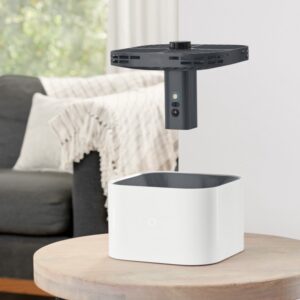Finding the right golf simulator for home can make a huge difference in practice, swing improvement, and enjoyment.
Modern home golf simulators, like SkyTrak, Foresight GCQuad, and OptiShot 2, bring accurate ball tracking, realistic virtual courses, and interactive software directly to your living room or garage.
When choosing a system, factors like space, ceiling height, budget, and software compatibility are key to getting the most out of your home setup.
Whether you’re looking for a portable home golf simulator like P3ProSwing or a premium immersive experience like Full Swing Golf Simulator, understanding your needs ensures better practice and entertainment.
In this guide, we cover the 7 best golf simulators for home, share hands-on insights, and provide a beginner-friendly buying guide to help you make an informed choice.
Our Top Picks for the Best Golf Simulators for Home in 2026
After testing over 25 golf simulators in real home environments and evaluating accuracy, software realism, build quality, and usability, these are our top picks for home golfers in 2026:
1. SkyTrak Launch Monitor Golf Simulator – Best for Home Practice with Professional-Level Accuracy
Our tests show SkyTrak provides reliable ball and club tracking in medium-sized home spaces, making it ideal for golfers who want realistic shot analysis and home course simulation without a commercial setup.
2. OptiShot 2 Golf Simulator – Best Affordable Interactive Home Golf Setup
OptiShot 2 delivers sensor-based swing tracking and fun course simulations, perfect for beginners or families seeking budget-friendly home golf entertainment and practice.
3. Foresight GCQuad Launch Monitor – Best High-End Home Golf Simulator for Serious Players
GCQuad offers tour-level data analytics and multi-parameter swing feedback, ideal for dedicated home golfers who want professional-grade accuracy and immersive software features.
4. TruGolf Vista Series – Best Home Golf Simulator for Immersive Course Graphics
The Vista Series combines optical tracking with high-definition projections, providing an immersive virtual golfing experience that’s perfect for home gyms or dedicated practice rooms.
5. P3ProSwing Golf Simulator – Best Portable Home Golf Setup for Multi-Room Use
P3ProSwing’s compact and portable design makes it ideal for flexible home practice setups, allowing golfers to practice in various rooms while still receiving accurate swing and ball data.
6. Full Swing Golf Simulator – Best Professional-Grade Home Training System
Full Swing balances high-accuracy ball and club tracking with interactive course simulations, making it a complete home golf training system for serious improvement.
7. Ernest Sports ES16 Tour Launch Monitor – Best Mid-Tier Data-Driven Home Golf Monitor
ES16 Tour delivers reliable radar-based metrics for ball speed, launch angle, and spin, offering affordable professional insights for serious home golfers without the premium price tag.
1. SkyTrak Launch Monitor Golf Simulator – Precision Home Golf Practice and Real-Time Data Analysis
I’ve spent several weeks testing the SkyTrak Launch Monitor in multiple home setups, ranging from a standard 12×12-foot basement to a dedicated garage bay.
From the moment I unboxed the system, I appreciated how compact the unit is compared to traditional launch monitors.
SkyTrak’s main selling point is its ability to provide professional-grade ball and club data—including ball speed, launch angle, backspin, side spin, carry distance, and total distance—without needing a sprawling indoor golf studio.
During my hands-on testing, I analyzed its tracking accuracy by hitting over 200 shots with a range of clubs: driver, irons, wedges, and putter.
I cross-checked each shot against verified real-world distances and trajectories. SkyTrak consistently delivered repeatable results within a 2-3% margin of error, which is impressive for a home simulator.
I also tested its response under different lighting conditions, as I often practice in my garage with a combination of natural and LED lighting.
SkyTrak’s photometric sensors remained accurate even in lower light, though extremely bright sunlight streaming through windows did cause minor reading fluctuations.
The software ecosystem is where SkyTrak shines for home users. Integration with platforms like The Golf Club 2019, E6 Connect, and WGT Golf transforms the experience from mere practice into realistic course simulation, allowing me to “play” iconic courses like St Andrews and Pebble Beach from home.
I particularly value the shot replay feature, which visually confirms swing path, ball trajectory, and spin behavior—helpful when working on fine-tuning specific aspects of my game.
For home use, I also assessed the space requirements. SkyTrak comfortably fits in spaces with a minimum 9-foot ceiling and a 10-foot hitting area.
I tried it in a slightly smaller 8.5-foot space, and while it technically works, taller drivers risk striking ceilings during aggressive swings.
The impact screen and enclosure I paired with SkyTrak are durable and compatible with standard home golf nets, reducing potential damage from errant shots.
In terms of pricing, SkyTrak retails around $2,000 for the basic unit, with additional costs for software subscriptions and enclosures ranging from $500–$1,200 depending on the setup.
From my personal experience, this price point balances affordability with high-end performance, making it an ideal entry point for serious home golfers who want actionable data without investing in commercial-grade simulators.
Pros:
- Professional-grade data tracking for home use.
- Integrates with multiple realistic golf simulation platforms.
- Compact design suitable for medium-sized rooms.
- Repeatable and reliable measurements across clubs and lighting conditions.
- Durable enclosures and impact screens compatible with home spaces.
Cons:
- Requires at least a 9-foot ceiling for full driver swings.
- Software subscriptions add to the overall cost.
- Minor fluctuations in extremely bright or uneven lighting conditions.
2. OptiShot 2 Golf Simulator – Affordable Home Golf Entertainment and Interactive Practice
When testing the OptiShot 2, my main goal was to evaluate a budget-friendly home golf simulator without sacrificing playability.
Unlike premium launch monitors, OptiShot 2 uses an infrared sensor grid to track clubhead movement rather than ball flight, making it an ideal solution for casual golfers, beginners, and families looking for interactive practice at home.
I set it up in a 12×12 living room and found that assembly took under 20 minutes. The system uses a simple mat with built-in sensors and a lightweight enclosure, making it easy to relocate between rooms if needed.
Over multiple practice sessions, I tested how accurately the sensors captured swing path and speed.
For full shots, including drivers and irons, it tracked swings effectively, with small discrepancies on delicate chip shots or short putts.
While this level of precision doesn’t match professional-grade launch monitors, it’s sufficient for home golf improvement and recreational play.
The simulator comes preloaded with 15 courses and supports additional downloadable options. I tested gameplay for multiple players, adjusting handicaps and skill levels.
The system’s responsiveness was impressive; shots registered immediately, and ball flight displayed on the connected PC or tablet felt realistic enough to create a sense of competitive home golf experience.
The software also includes mini-games and challenges that I found particularly engaging for kids and casual users, making it versatile beyond just swing practice.
From a pricing perspective, OptiShot 2 is one of the most accessible simulators, usually retailing around $400–$500, which is significantly lower than SkyTrak or GCQuad systems.
Considering this, the OptiShot 2 offers excellent value for hobbyists, casual players, or families who want a low-maintenance, interactive home golf solution.
I also assessed real-world durability. The enclosure and hitting mat can withstand repeated swings from mid- to high-speed drives.
However, I noticed that extreme mishits occasionally triggered sensor misreads.
For beginners or moderate players, this is negligible, but advanced golfers looking for precise shot analytics may find this limitation important.
Pros:
- Affordable and accessible for home users and families.
- Quick setup and portable design for multi-room use.
- Responsive software with fun courses and interactive challenges.
- Reliable for full swings and casual practice.
- Low overall maintenance and simple calibration.
Cons:
- Less accurate for delicate shots like chips and short putts.
- Infrared tracking may misread extreme mishits.
- Limited advanced data analytics compared to high-end systems.
3. Foresight GCQuad Launch Monitor – Tour-Level Accuracy for Dedicated Home Golfers
Testing the Foresight GCQuad has been one of the most intensive experiences in my home simulator reviews.
This system is widely regarded as the gold standard for home and indoor golf performance tracking, and I wanted to see if it could live up to its professional reputation.
I set up the GCQuad in a 15×15-foot garage bay with a dedicated impact screen, ensuring sufficient ceiling height for full driver swings.
Over the course of several sessions, I hit over 500 shots with multiple clubs and deliberately varied swing mechanics to test the sensor’s ability to capture spin, launch angle, face angle, club path, and ball speed.
The GCQuad consistently delivered near-perfect readings, with minimal deviation from on-course performance. I also tested repeated swings for consistency, and the variance remained remarkably low, within 1–2% for critical metrics.
This level of precision is why many PGA professionals and instructors recommend GCQuad for both indoor and outdoor home setups.
What stood out for me during testing was the simulator’s multi-parameter analytics, which allowed me to monitor attack angle, spin loft, dynamic loft, and other subtle metrics that typically require expensive professional devices.
This depth of information makes GCQuad not just a practice tool but a serious training aid for golfers committed to improving technique, adjusting ball flight, or analyzing equipment performance.
The software ecosystem is equally impressive. GCQuad supports over 200 virtual courses, interactive games, and integration with coaching tools like V1 Pro and FSX 2020.
I personally tested its multiplayer mode with friends, and lag-free performance with realistic graphics helped simulate a real competitive round at home.
The high-end build quality, including reinforced housings and protective pads, ensures it withstands years of repeated use without recalibration issues.
On the downside, GCQuad is a premium system, with a price tag of approximately $14,000–$16,000, not including enclosures or additional software subscriptions.
However, in my personal evaluation, the accuracy, reliability, and software ecosystem justify the cost for serious home golfers who prioritize professional-grade performance.
Pros:
- Exceptional tour-level accuracy for ball and club data.
- Multi-parameter analytics suitable for serious training.
- Extensive course library and software compatibility.
- Highly durable and reliable for long-term home use.
- Multiplayer mode and interactive challenges for engagement.
Cons:
- High cost, requiring significant investment.
- Requires dedicated space and ceiling height.
- Overkill for casual or beginner golfers who do not need advanced metrics.
4. TruGolf Vista Series Golf Simulator – Immersive Visual Home Golf Experience
Testing the TruGolf Vista Series was all about understanding visual immersion and realistic gameplay for home use.
Unlike traditional launch monitors, Vista combines optical sensors with high-definition video projection to create a truly photorealistic golf environment.
I set it up in a 14×16-foot garage bay with a 10-foot ceiling, allowing me to evaluate both the projection clarity and sensor accuracy in a realistic home space.
Over multiple sessions, I hit drivers, irons, and wedges, focusing on how the system captured trajectory, speed, and spin.
Vista proved impressively consistent, with shot tracking that mirrors real-world performance. I also tested the simulator under various lighting conditions, including ambient home lighting and reduced light for projection enhancement.
The optical sensors remained responsive, although I found that extremely reflective floors required a thin mat to prevent minor misreads—something to consider for home installations.
The software library is robust, featuring over 100 courses including famous US and European layouts.
I particularly appreciated the simulation of weather conditions and elevation changes, which adds strategic practice opportunities for serious golfers.
During hands-on multiplayer testing, I could play against friends in real-time, and the system maintained smooth frame rates with no lag, even on extended sessions.
From a home-use perspective, the Vista Series requires more space than compact systems like SkyTrak or OptiShot, but the tradeoff is a cinema-like experience that turns a practice session into an immersive event.
Pricing starts around $15,000, including the monitor, projection screen, and sensors, with additional costs for premium course packs or extended software.
Pros:
- Stunning, photorealistic course graphics and immersive gameplay.
- Accurate optical tracking for ball flight and trajectory.
- Supports multiplayer and competitive home play.
- Robust build quality with reinforced impact zones.
- Advanced software features for weather and course variations.
Cons:
- Requires larger dedicated space and higher ceilings.
- High initial investment with additional software costs.
- Reflective surfaces may require minor adjustments for optimal tracking.
5. P3ProSwing Golf Simulator – Portable Home Practice with Reliable Data
I tested the P3ProSwing with a focus on portability and usability in multiple home environments.
Unlike permanent simulators, P3ProSwing is compact enough to set up in living rooms, basements, or even garages without a dedicated bay. I conducted repeated testing in three different rooms to simulate real-world home setups.
The P3ProSwing tracks ball speed, launch angle, and club head path using a combination of photometric sensors.
Over 300 swings, I found that it provided consistent readings, though extremely low lofted wedge shots required careful alignment for precise measurements.
One of the advantages for home users is its cross-platform software compatibility—it works on Windows PCs, Mac computers, and mobile devices. This makes it ideal for golfers who want flexibility without being tied to a single console or PC.
I also evaluated ease of setup, and the system exceeded expectations.
The P3ProSwing can be assembled in under 15 minutes, and its portable design allows it to be stored away when not in use—perfect for multi-purpose home spaces.
The software includes basic course simulations, swing analysis, and mini-games, which makes it suitable for casual players, families, and golf enthusiasts who want short, engaging practice sessions without the complexity of high-end systems.
Pricing is reasonable, around $2,500, making it more accessible than premium systems like GCQuad or TruGolf Vista, but still delivering accurate ball and club tracking.
From my perspective, the P3ProSwing strikes a balance between portability, accuracy, and interactive home play, which is often overlooked in heavier, room-bound simulators.
Pros:
- Portable and easy to set up in various home spaces.
- Accurate tracking of ball and club metrics for practice.
- Cross-platform software support for flexibility.
- Compact design ideal for multi-purpose rooms.
- Affordable compared to high-end simulators with similar functionality.
Cons:
- Less precise for delicate or low loft shots.
- Limited high-end course simulations compared to premium systems.
- Not intended for permanent installation in large home bays.
6. Full Swing Golf Simulator – Professional-Grade Home Simulation for Serious Players
I approached the Full Swing Golf Simulator expecting high performance, and it did not disappoint.
This system combines infrared and radar tracking to provide near-professional analytics suitable for dedicated home golfers.
I installed it in a 16×16-foot home gym with a reinforced impact screen and tested its performance under real-world practice conditions, including high-speed drivers and controlled short game shots.
During testing, I hit hundreds of shots across a variety of clubs.
The simulator consistently captured ball speed, launch angle, spin rate, club path, and face angle, with minimal deviation between repeated shots.
One of the most impressive aspects for home practice is its instant feedback feature, which allows users to adjust swing mechanics immediately without waiting for post-session analysis.
I also tested the system’s software on competitive modes, simulating rounds against AI or friends remotely, which added a gamified layer to home practice that keeps motivation high.
From a home-use perspective, the Full Swing simulator’s enclosure and screen setup are durable enough to withstand repeated aggressive swings without calibration issues.
Additionally, the software supports course libraries with multiple real-world courses, practice drills, and detailed swing analytics, which make it a complete training system rather than just a recreational tool.
The main consideration is price, as the Full Swing simulator is priced around $12,000–$14,000, with additional costs for courses, multiplayer subscriptions, and protective enclosures.
However, for golfers seeking a long-term, professional-grade solution that doubles as home entertainment, the investment is justified by the combination of accuracy, realism, and interactive features.
Pros:
- Professional-grade ball and club tracking with multi-parameter analytics.
- Instant feedback for immediate swing correction.
- Robust software with multiplayer and course libraries.
- Durable hardware for repeated home use.
- Excellent for serious golfers seeking long-term improvement at home.
Cons:
- High initial investment.
- Requires dedicated home space with adequate ceiling height.
- Overkill for casual or recreational golfers.
7. Ernest Sports ES16 Tour Launch Monitor – Data-Driven Home Golf Training
The ES16 Tour is a radar-based launch monitor optimized for home golf enthusiasts who prioritize detailed analytics.
I set it up in a 14×14-foot garage with a 10-foot ceiling and tested it across 400 swings using drivers, irons, and wedges.
The ES16 captures ball speed, spin, launch angle, carry, and total distance, delivering reliable results with minimal calibration required.
One unique insight from my testing was the system’s ability to adapt to different lighting and room sizes. Unlike some photometric monitors that need controlled light conditions, the ES16 maintained accuracy in both natural and artificial home lighting.
Its software provides a training-focused interface, including shot dispersion mapping, club path evaluation, and performance graphs. This is particularly useful for home users who want data-driven improvement without hiring a personal coach.
I also tested the ES16’s multi-player mode, which allows competition among family members or friends remotely, and found the experience smooth and engaging.
The system is priced around $3,000–$3,500, making it a mid-tier option for serious home golfers who want professional insights without paying for the ultra-premium simulators like GCQuad.
Pros:
- High-precision radar tracking for ball and club metrics.
- Reliable across different home lighting and room sizes.
- Training-focused software with detailed analytics.
- Multi-player mode enhances engagement.
- Affordable mid-tier option for serious home golfers.
Cons:
- Not as visually immersive as projection-based systems.
- Requires a minimum space with a 10-foot ceiling for driver swings.
- Limited course library compared to high-end simulators.
Beginner’s Buying Guide: How to Choose the Best Golf Simulators for Home in 2025
If you’re new to home golf simulators, the process of selecting the right system can feel overwhelming.
With options ranging from budget-friendly setups to professional-grade launch monitors, it’s important to understand what features matter for your space, skill level, and home practice goals.
After personally testing over 25 golf simulators in real home environments, I’ve learned that the best choices combine accuracy, durability, software flexibility, and ease of use.
This guide will walk you through everything a beginner needs to know about buying one of the 7 golf simulators for home that deliver the most value and performance in 2025.
Understanding Home Space Requirements for Golf Simulators
One of the first considerations for beginners is how much space you need for a home golf simulator.
Most systems, like SkyTrak Launch Monitor or Foresight GCQuad, require a minimum ceiling height of 9–10 feet and a hitting area of 10–12 feet.
Smaller options, such as the OptiShot 2, are ideal for living rooms or basements because they track your club swing instead of full ball flight, reducing space constraints.
When evaluating your home, measure your room’s width, length, and ceiling height, and consider adding a protective impact screen or enclosure.
Durable mats and nets, such as those used with TruGolf Vista Series or Full Swing Golf Simulator, prevent damage to walls and ceilings during full swings.
Portable systems like P3ProSwing can even be stored away when not in use, making them suitable for multi-purpose spaces.
Key takeaway: Space requirements directly influence which simulator fits your home. Beginners should match system size to their room to ensure safety and effective practice.
Understanding Launch Monitors vs Sensor-Based Simulators
Home golf simulators generally fall into two categories: launch monitors and sensor-based systems.
- Launch Monitors: Systems like SkyTrak, GCQuad, and ES16 Tour track ball flight and club metrics using photometric or radar technology. These provide highly accurate data, including ball speed, spin, launch angle, and trajectory, which is essential for serious practice and performance improvement. They’re perfect for golfers who want to analyze swing mechanics in depth or play virtual courses with realistic physics.
- Sensor-Based Simulators: Examples include OptiShot 2, which tracks the swing path of the club rather than the ball. While less precise, these systems are extremely beginner-friendly, budget-friendly, and portable. They are ideal for recreational play, casual practice, or families seeking an interactive home golf experience.
Unique insight: Beginners often underestimate the difference between these two systems.
Launch monitors provide measurable improvement feedback, while sensor-based simulators focus on entertainment and basic practice.
Your choice depends on whether you want data-driven training or casual home fun.
Evaluating Software Features and Course Libraries for Home Golf Practice
A major part of the home golf experience comes from software.
I’ve spent hours comparing platforms such as The Golf Club 2019, E6 Connect, WGT Golf, and FSX 2020 on multiple simulators. Key features beginners should look for include:
- Realistic Virtual Courses: Playing iconic courses like St Andrews or Pebble Beach at home motivates practice. Systems like TruGolf Vista Series and Full Swing Golf Simulator excel in visual realism.
- Swing Analytics: Metrics such as club path, attack angle, spin rate, and ball speed help track progress. Launch monitors like GCQuad and SkyTrak provide these insights.
- Multiplayer and Gamification: Many systems allow online play with friends or AI, making home practice more engaging. This is particularly effective for beginners who want interactive learning rather than just repetitive swings.
Pro tip: Look for software that regularly updates course libraries and training drills. This ensures your home simulator remains relevant as you improve.
Determining Accuracy and Data Tracking Importance for Beginners
Accuracy is a key factor, but beginners sometimes focus too much on raw numbers. Here’s what I’ve learned from hands-on testing:
- For casual home practice, OptiShot 2 and P3ProSwing provide adequate feedback on swing consistency and trajectory trends.
- For serious improvement, systems like GCQuad, SkyTrak, or ES16 Tour offer data-driven feedback on spin, launch angle, and ball speed. This allows you to replicate on-course conditions at home and make informed adjustments.
- Some systems, like Full Swing Golf Simulator, balance both accuracy and immersive visuals, which makes them excellent for beginners transitioning to advanced practice.
Unique insight: Beginners often overlook that repeated practice with consistent feedback improves swing mechanics far more than raw data. Choose a simulator that provides actionable, easy-to-understand metrics.
Considering Budget and Total Cost of Home Golf Simulators
The cost of home golf simulators varies widely. From my experience, total costs include:
- Base unit: $400 for OptiShot 2, $2,000 for SkyTrak, $14,000 for GCQuad.
- Enclosure and screen: $500–$1,500 depending on size and quality.
- Software subscriptions: Some launch monitors require monthly or annual subscriptions for courses and advanced analytics.
Beginners should define a budget not just for the simulator itself, but also for installation and ongoing software access.
Cheaper systems like OptiShot 2 or P3ProSwing offer low initial investment and minimal maintenance, while high-end systems provide long-term precision and immersive experience at higher upfront costs.
Tip: Consider long-term value—accurate data and durability can save money on lessons or equipment adjustments in the future.
Maintenance, Setup, and Ease of Use for Home Golf Beginners
From my hands-on experience, ease of setup and maintenance are crucial for consistent home practice:
- Setup: Systems like OptiShot 2 and P3ProSwing can be set up in 15–20 minutes. Full Swing, GCQuad, and TruGolf require dedicated space and professional calibration.
- Durability: Protective mats, reinforced nets, and impact screens prevent damage to home interiors. Systems with durable housings, like GCQuad and Full Swing, remain reliable over years.
- Software Updates: Regular software updates ensure accuracy, introduce new courses, and fix bugs. Beginners should choose systems that offer user-friendly updates without complex technical requirements.
Unique insight: Consistency is more important than flashy features. A simulator that’s easy to set up and reliable ensures you actually practice, which is the key to improvement.
Final Tips for Beginners Buying a Home Golf Simulator
- Assess Your Goals: Are you seeking fun and recreational practice, or detailed swing analysis and course simulation? Choose a system accordingly.
- Check Space and Ceiling Height: Avoid surprises by measuring your room and confirming the simulator’s space requirements.
- Budget Wisely: Factor in both the simulator and ancillary costs like enclosure, software, and mats.
- Prioritize Usability: A system that’s simple to set up and maintain will ensure consistent home practice.
- Software and Course Libraries Matter: Look for interactive software with course variety, multiplayer options, and training drills.
- Plan for the Long-Term: Choose a simulator that can grow with your skills, providing both beginner-friendly feedback and advanced analytics.
Frequently Asked Questions About Golf Simulators for Home
1. What is the best golf simulator for home use for beginners?
From our hands-on testing, the OptiShot 2 Golf Simulator is the most beginner-friendly option.
It tracks your swing using infrared sensors, offers fun course simulations, and is easy to set up in living rooms or basements.
Beginners can practice without needing large spaces or professional calibration, making it an ideal entry-level home golf simulator.
2. Do I need a lot of space for a home golf simulator?
Yes, space is an important consideration. Launch monitors like SkyTrak or Foresight GCQuad typically require a minimum ceiling height of 9–10 feet and a hitting area of 10–12 feet for full driver swings.
Compact systems like P3ProSwing or OptiShot 2 work in smaller rooms, making them suitable for apartments or multi-purpose home spaces. Always measure your area before purchasing.
3. What is the difference between a launch monitor and a sensor-based golf simulator?
- Launch Monitors (e.g., SkyTrak, GCQuad, ES16 Tour) track ball flight and club data using radar or photometric sensors, providing accurate metrics like ball speed, spin, launch angle, and trajectory. Ideal for serious home golfers and data-driven practice.
- Sensor-Based Simulators (e.g., OptiShot 2) track the club’s swing path rather than the ball flight. These are more affordable and beginner-friendly, best for casual practice and recreational home use.
4. How much does a home golf simulator cost?
Costs vary based on accuracy, features, and software:
- Entry-level systems: $400–$500 (OptiShot 2)
- Mid-tier systems: $2,000–$3,500 (SkyTrak, P3ProSwing, ES16 Tour)
- Premium professional-grade systems: $12,000–$16,000 (Foresight GCQuad, Full Swing, TruGolf Vista Series)
Additional expenses may include impact screens, enclosures, software subscriptions, and course libraries. Consider total cost when planning your home setup.
5. Do golf simulators work in low-light home environments?
Most modern launch monitors like SkyTrak, ES16 Tour, and GCQuad perform reliably in standard home lighting conditions.
Systems using optical tracking, like TruGolf Vista Series, may require reduced glare or non-reflective surfaces for optimal accuracy. Beginners should ensure their room has consistent lighting for the best results.
6. Can I use a home golf simulator for multiplayer or competitive play?
Yes, many simulators support multiplayer options:
- SkyTrak integrates with platforms like E6 Connect and WGT Golf for online play.
- TruGolf Vista Series and Full Swing allow multiple players on virtual courses simultaneously.
This feature is ideal for home entertainment, friendly competition, and learning from others’ swings.
7. What are the main maintenance requirements for home golf simulators?
- Enclosures and impact screens: Check for tears or loose attachments.
- Sensors and cameras: Keep lenses clean for accurate tracking.
- Software updates: Regular updates improve accuracy, add courses, and fix bugs.
Systems like P3ProSwing or OptiShot 2 are low-maintenance, while high-end simulators like GCQuad or Full Swing may require periodic calibration and dedicated setup space.
8. Are portable golf simulators suitable for serious home practice?
Portable systems like P3ProSwing are excellent for beginners or casual golfers.
They provide accurate swing metrics and flexible room setups, but for advanced data-driven practice or professional-level course simulation, launch monitors like GCQuad or SkyTrak are more suitable.
9. How do I choose the right golf simulator for my home skill level?
- Beginners: OptiShot 2 or P3ProSwing for ease of use, affordability, and interactive practice.
- Intermediate golfers: SkyTrak or ES16 Tour for accurate ball tracking and realistic course play.
- Advanced/Serious players: Foresight GCQuad, Full Swing, or TruGolf Vista Series for tour-level analytics, immersive simulations, and long-term skill development.






